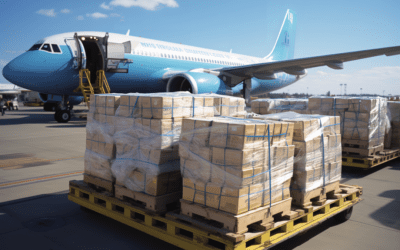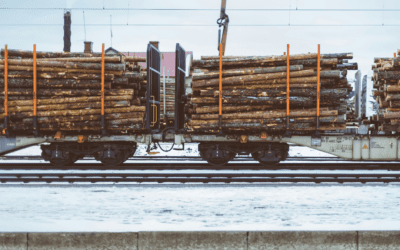Resins are an incredibly versatile class of materials with applications spanning from construction and electronics to food and beverages. Their mechanical properties and strength make them vital in various industries.
However, resins can also be challenging to transport because of specific requirements for storage and transportation. Mishandling can lead to increased costs and environmental impacts, adversely affecting a business’s profitability.
In 2019, resin production exceeded 120 billion pounds, emphasizing the critical role of efficient bulk transportation within the supply chain. Bulk transportation plays a crucial role in shipping various products and the packaging containers they use. Large amounts of resin involve an efficient flow from production to a vast supply chain. Once companies package resins, they transform them into products for everyday use.
Navigating the complexities of resin transportation is vital for businesses looking to streamline operations and reduce costs. Companies can be proactive about complications by understanding the type of resin they’re transporting, the containers, and the packaging methods.
Article Overview
Doubling Down on Durability
Resins come in various forms, each with its own unique properties. One aspect that sets resins apart is their durability. Some resins are more durable than others and can withstand higher temperatures and other modes of transportation.
- Epoxy Resin
This synthetic polymer has become increasingly popular in many industries due to its durability and versatility. Epoxy resin serves as a prime example of a robust resin that is adaptable to various transportation modes.
- Polyurethane Resin
Polyurethane is also very versatile, existing in multiple forms, such as lightweight to dense compositions. However, maintaining the quality of polyurethane during transit is more intricate than other resins.
Typically shipped in 500-to-550-pound steel drums, bulk deliveries often involve tank trucks and demountable tanks. Shipments must contain 44,000 pounds (20 metric tons) or 190,000 pounds (86 metric tons) if shipped in tank trucks. Polyurethane is much more complex in maintaining the quality during transit, requiring specific temperatures.
While the durability of resins is an important factor during transportation, the type of shipping mode is even more critical. Resins must be properly handled, stored, and transported. Here are containers that can preserve resin during storage and transportation.

- Resin Bins
These plastic containers are specially made for storing and handling resin materials. Resin bins usually come with strong casters to make it easy to move bulk solids. Some bins can be made from high-density polyethylene, allowing individuals better visibility of the contents inside. High-density polyethylene is effective due to its toughness and durability and can be easily cleaned to avoid cross-contamination.
- Powder Resin Bins
Similar to resin bins, powder resin bins are containers used for bulk quantities of powder and resin. These plastic resin containers are used in industrial buildings, manufacturing plants, and distribution hubs.
- Coated Bulk Bag
Some resins, such as acrylic-based resins, expand considerably it it’s rehydrated. To account for pellets expanding, the containers and trucks should have enough space to accommodate the volume increase if the pellets rehydrate.
When transporting acrylic-based resins, consider moisture-coated bulk bags. This type of bag has a thin layer on the inside to minimize airflow and moisture transmission.
Benefits in Bulk
Transporting resin is not a small task in terms of logistics and cost. Factors like packaging materials, container design, and storage considerations influence costs. Businesses must be aware of the contamination risk when handling these materials.
Using the same truck repeatedly and leaving behind various differently colored resin pellets from the previous load can render the end product unusable due to the mixing of colors. Mixing can render the load useless and cost the company a lot of money.
How can these issues be resolved? The cost of resin transportation can be optimized with different modes and containers, which doesn’t compromise the quality of the resin.
Strategies for Efficient Resin Transport
- Bulk Purchasing
Buying resin in bulk is the ultimate cost-saving strategy a business can practice. Strategies for managing resin supply and prices include bulk transport, storage, and better tracking. Generally, larger quantities translate into lower costs per unit. When businesses purchase large amounts of resin, it can help them ensure they have enough for production.
- Consider Modes of Transportation
When businesses consider bulk resin procurement, exploring various transportation modes can determine which is the better option for their needs. Two noteworthy options include:
- Truckload: This mode boasts a truck-fill line-proofing system, ensuring error-free resin loading.
- Rail: railroads leverage a railcar-unloading system and can accommodate approximately 200,000 lbs of resin, streamlining movement to bulk storage.
- Opt for Silos
Silos prove to be one of the most effective means of reducing material costs, offering efficient storage solutions.
- Bulk Containers
As for containers, the majority of companies are utilizing flexible intermediate bulk containers (FIBCs) due to the high cost-effectiveness of FIBCs over traditional containers. FIBCs are a great option for handling resin because of their robust barrier coatings.
These containers enhance stability when stacking bags, potentially saving companies a significant amount of money. Due to FIBCs capability of maximizing storage space and improvements in logistical efficiency, companies tend to gravitate towards these containers.
The adoption of FIBCs has been influenced by environmental sustainability, as they offer an environmentally friendly alternative compared to traditional packaging materials.

Supply Chain Sustainability
The chemical industry is increasingly implementing more sustainable practices and furthering their processes to be more circular rather than linear. Industries increasingly use renewable alternative resources in the production of a variety of materials and products, such as fuels, resins, and solvents.
In a recent survey by Gartner, 87% of businesses expressed their intent to increase investments in sustainability over the next two years. These results implied that the increase in such practices is due to growing customer, investor, and regulatory demands. Moreover, the survey found that sustainability created short and long-term value for businesses.
With growing trends around the practice of a circular economy, this can also support emissions reductions. Utilizing “greener” resins from plant materials has become a common practice in packaging strategies.
Sustainable Packaging
Reducing the amount of packaging generated is a positive step towards protecting our environment and reducing plastic pollution. One way to reduce packaging waste is by purchasing larger quantities at once rather than smaller ones. Fiber-reinforced polymer (FRP) composites are also a great option for sustainable packaging. They are an alternative to traditional monolithic materials due to their strength.
KCH Transportation Specializes in Bulk Hazmat
At KCH Transportation, we provide tailored solutions for all types of freight, including hazardous materials and chemicals. When you choose KCH Transportation, you partner with an expert in shipping bulk hazmat. We guide companies in finding comprehensive solutions to fit their needs and invest in the success of each process.
Contact us today to learn how KCH Transportation can meet your unique shipping requirements and guarantee the safe delivery of bulk hazmat materials.






